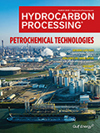Treating
Reliability: Comparing and updating aeration blower technologies
As the main consumers of electricity in a wastewater treatment plant, aeration blowers can significantly affect the overall cost of plant operation.
Hydrocarbon Processing Awards
<i>Hydrocarbon Processing,</i> the downstream processing sector’s leading technical publication, has announced the finalists for its third annual awards.
Executive Viewpoint: Now and into the future: Challenges and solutions for the global processing industries
<i>Hydrocarbon Processing</i> sat down with senior-level executives of Merichem Company, Cyndie Fredrick (CF) and Kathy Young (KY), Senior Vice Presidents and General Managers of Merichem’s two business units, to discuss the state of the downstream industry, where it is heading in the future and how their company is helping operators meet their sustainability goals.
Editorial Comment: A shift in capital? Petrochemical projects take lead in active project market share
In mid-June, I joined Thad Pittman, Senior Research Analyst, <i>Hydrocarbon Processing’s</i> Construction Boxscore Database, to provide <i>Hydrocarbon Processing</i> subscribers with a global analysis on the downstream processing industry’s capital projects landscape.
FCC metal trap additives to process more residue
Most refiners frequently need metal trapping or bottoms cracking additives for residue operations.
Editorial Comment: The true essence of optimization
What is the first thing that comes to mind when we hear the word optimization?
Construction
Sinochem Hongrun Petrochemical Co. Ltd. will use Honeywell UOP’s ionic liquids alkylation technology to produce high-octane, cleaner-burning transportation fuels.
Business Trends: Sustainability: Clean fuels—The advancement to zero sulfur
In April, Hydrocarbon Processing launched the first iteration of its HP Sustainability webcast series.
Industry Perspectives: What topics do you want to hear about?
Throughout Hydrocarbon Processing’s 97 yr of publishing technical material for the refining and petrochemical industries, the journal has focused on numerous topics to optimize downstream processing facility operations.
Mitigating corrosion challenges from opportunity crudes
High-quality crudes are not always readily available, or at a price that is acceptable to the producer’s budget.

- Evonik presents innovative "Debonding on Demand" concept for more sustainable bonding 4/3
- Oil, gas and refined product imports exempted from Trump’s sweeping tariffs 4/3
- Reliance: India's gasoline demand to peak by 2035, diesel by 2041 4/3
- Mabanaft, HIF Global sign agreement to accelerate e-methanol adoption in the shipping industry 4/3
- Burckhardt Compression awarded digital monitoring services contract for a chemical plant in Saudi Arabia 4/3
- Lummus completes successful startup of electric heater demonstration unit 4/3




